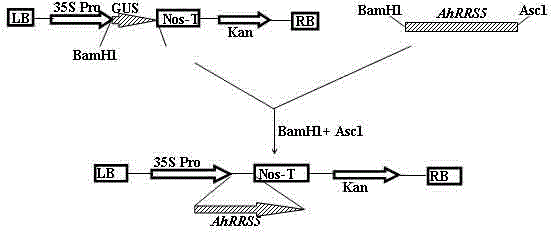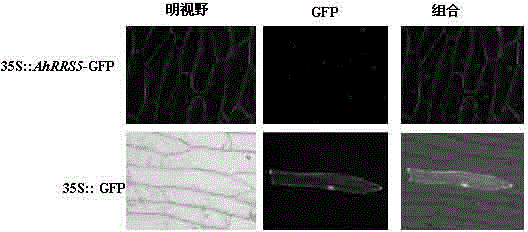NBS-LRR (nucleotide binding site-leucine-rich repeat) gene in arachis hypogaea.L and application thereof to bacterial wilt resistance of tobaccos
A gene and peanut technology, applied in application, genetic engineering, plant genetic improvement, etc., can solve the problems affecting molecular breeding of peanut resistance to bacterial wilt, and achieve the effect of improving bacterial wilt resistance and important application value
- Summary
- Abstract
- Description
- Claims
- Application Information
AI Technical Summary
Problems solved by technology
Method used
Image
Examples
Embodiment 1
[0019] [Example 1] RACE acquisition AhRRS5 Gene 3' Unknown Sequence and 5' Unknown Sequence
[0020]Based on peanut abiotic and biotic stress 454 sequenced transcripts, the peanut expression profile gene chip (synthesized by Roche Company) was combined, and the candidate gene fragments were obtained by hybridization of the chip hybridization before and after inoculation of R. solanacearum strains before and after induction of R. solanacearum. Design a pair of gene primers PRRS_5_F (5'- GCTTTGTAGAGGCAAATCAAGGCTG -3') and PRRS_5-R (5'- TGAAGAGAAGGCATCCAATCAGGTAAG -3'); then add the linker sequence RACE-F (AAGCAGTGGTATCAACGCAGAGTGGCCAT) and RACE-R (ATTCTAGAGGCCGAGGCGGCCGACATGd(T)30N-1N-3'), using PRRS_5-R primers and RACE-F primers and PRRS_5_F primers and RACE-R primers for 5' and 3'- RACE reactions, respectively, 5'- RACE reaction conditions are 94°C 5min→(94°C 30s→57°C 30s→72°C 2min) 30 cycles→72°C 10min; 3′-RACE reaction conditions are 94°C 5min→(94°C 30s→72°C 2min) 5cycles→...
Embodiment 2
[0021] [Example 2] AhRRS5 Construction and verification of overexpression vector
[0022] AhRRS5-OE-F (5'- ATTAGGATCCACCATGGCTGAGAGTGCCATAGCCT-3') and AhRRS5-OE-R (5'- ATTTAGGCGCGCCTACACCTTTGAGAGAGTGCTGCGT-3') primers were amplified from a plasmid with a complete reading frame including the stop codon AhRRS5 Gene cDNA open reading frame, with BamH1 and Asc1 restriction sites at the 5′ end and 3′ end respectively, for pBI121-GUSA driven by 2×CaMV 35S promoter constructed in our laboratory and amplified AhRRS5 The target fragment was double digested with BamH1 (purchased from NEB Company) and Asc1 (purchased from NEB Company) at the same time, the target fragment was recovered, ligated with T4 ligase overnight at 16°C, transformed into E. coli DH5α strain, and p35S::AhRRS5-OE was constructed The overexpression vector has been verified by PCR and enzyme digestion to confirm the correctness of its vector construction. The vector diagram is as follows: figure 2 shown. Agrobacte...
Embodiment 3
[0023] [Example 3] AhRRS5 Subcellular localization of gene expression products
[0024] For subcellular localization vectors, amplify from a plasmid with complete reading frame by primers AhRRS5-SL-F (5'-ATTAGGATCCACCATGGCTGAGAGTGCCATAGCCT-3') and AhRRS5-SL-R (5'-ATTAGGCGCGCCACACCTTTGAGAGAGTGCTGCGT-3') get excluding the kill password AhRRS5 Gene cDNA, with BamH1 and Asc1 restriction sites at the 5' end and 3' end respectively, for the pBI-GFP constructed in our laboratory and the amplified AhRRS5 The gene was double digested with BamH1 and Asc1 at the same time, and p35S was constructed after ligation and transformation:: AhRRS5 ::GFP vector. The successfully identified recombinant plasmid was bombarded with a gene gun on the onion epidermis, and after being introduced into the onion epidermis, the plate was placed in a tissue culture room and cultured in the dark for 24-36 hours, so that the GFP fusion protein encoded by the plasmid was fully expressed in the onion epiderm...
PUM
 Login to View More
Login to View More Abstract
Description
Claims
Application Information
 Login to View More
Login to View More - R&D
- Intellectual Property
- Life Sciences
- Materials
- Tech Scout
- Unparalleled Data Quality
- Higher Quality Content
- 60% Fewer Hallucinations
Browse by: Latest US Patents, China's latest patents, Technical Efficacy Thesaurus, Application Domain, Technology Topic, Popular Technical Reports.
© 2025 PatSnap. All rights reserved.Legal|Privacy policy|Modern Slavery Act Transparency Statement|Sitemap|About US| Contact US: help@patsnap.com



